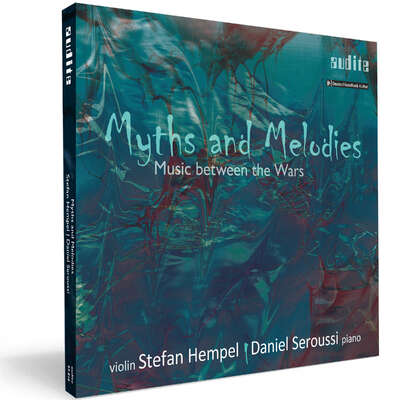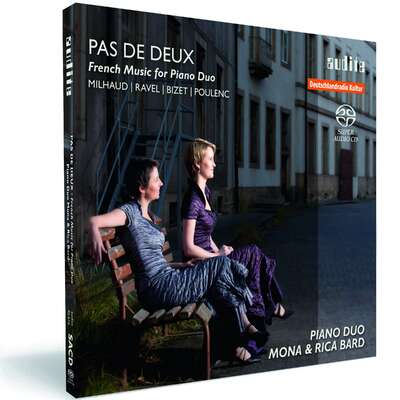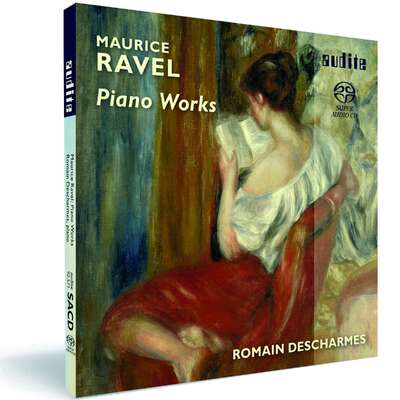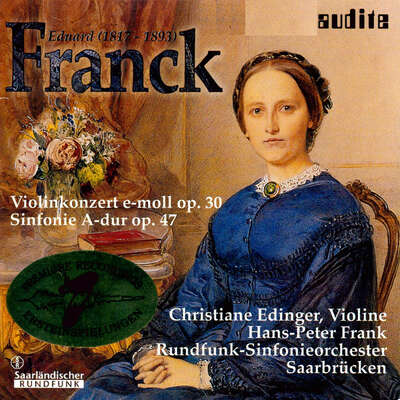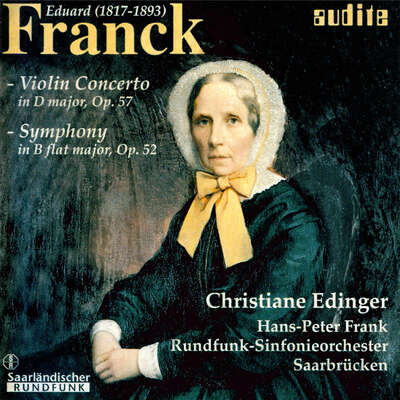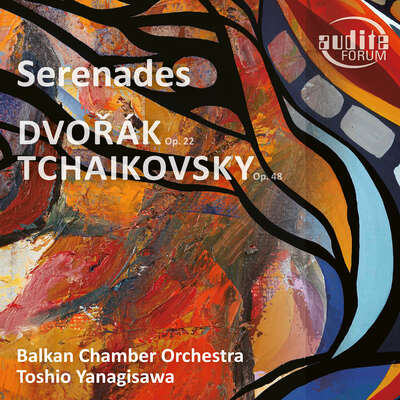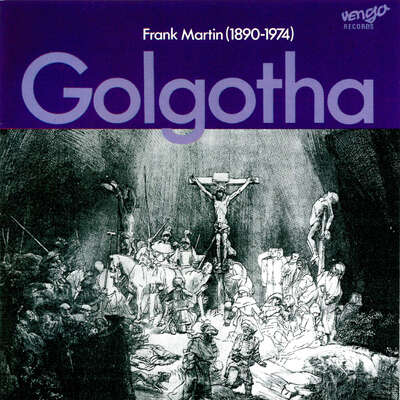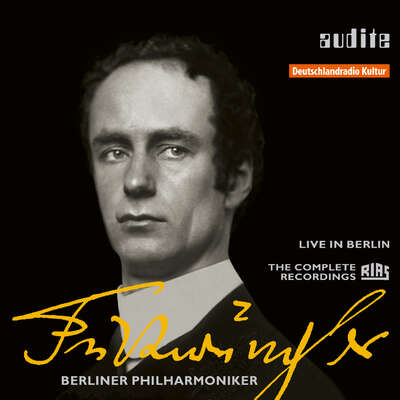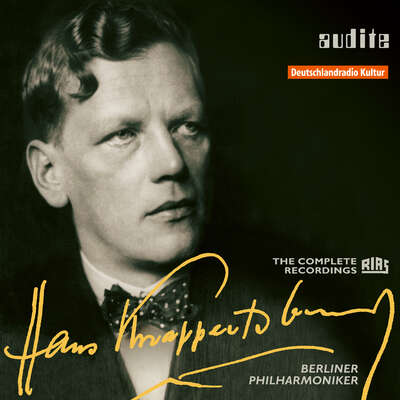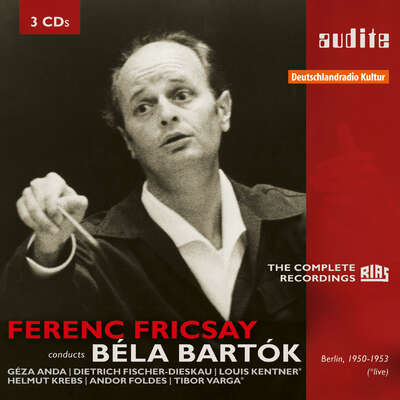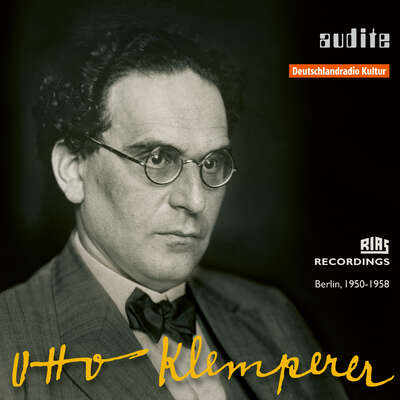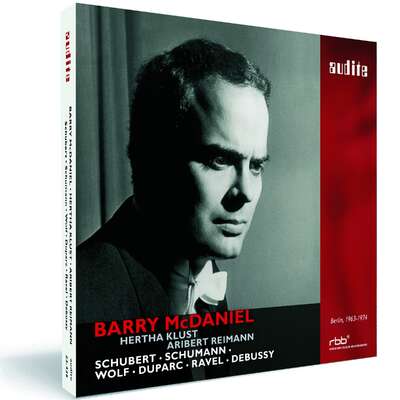
Auch die zweite audite-Produktion mit Igor Markevitch dokumentiert seine Konzentration auf rhythmische Präzision und Transparenz des Orchesterklangs: Igor Strawinskys „Sacre du Printemps“ , der bei der Uraufführung durch Serge Diaghilews „Ballets Russes“ 1913 im Pariser Théâtre des...mehr
"Höhepunkt dieser Erstveröffentlichungen ist aber natürlich Markevitchs archaische Gangart in Strawinskys „Le sacre du printemps“. Und der historische Klang, der bei allen Hi-Fi-verwöhnten Ohren nervöses Zucken auslösen wird, ist hier nicht etwa Zeugnis einer vergangenen Epoche, sondern entpuppt sich in dieser ultra-modernen Interpretation als integraler und somit sinnstiftender Parameter." (Rondo)
Details
| Igor Markevitch conducts Ravel, Stravinsky and Honegger | |
| Artikelnummer: | 95.605 |
|---|---|
| EAN-Code: | 4022143956057 |
| Preisgruppe: | BCB |
| Veröffentlichungsdatum: | 17. Juli 2009 |
| Spielzeit: | 73 min. |
Zusatzmaterial
Informationen
Auch die zweite audite-Produktion mit Igor Markevitch dokumentiert seine Konzentration auf rhythmische Präzision und Transparenz des Orchesterklangs: Igor Strawinskys „Sacre du Printemps“, der bei der Uraufführung durch Serge Diaghilews „Ballets Russes“ 1913 im Pariser Théâtre des Champs-Élysées einen der größten Skandale der Musikgeschichte provoziert hatte, stellte auch in den 1950er Jahren noch eine beträchtliche Herausforderung für jedes Orchester dar. Igor Markevitch galt damals als der souveränste Dirigent des „Sacre“, der wie kein anderer die rhythmischen und spieltechnischen Probleme dieser Partitur zu meistern verstand.
Dass das junge RIAS-Symphonieorchester Markevitchs Intentionen in besonderer Weise entgegenkam, belegen auch die virtuosen, in Klang und Rhythmus perfekten Wiedergaben von Ravels 2. „Daphnis und Chloé“-Suite und der 5. Symphonie von Arthur Honegger, die Markevitch ein knappes Jahr nach ihrer Bostoner Uraufführung in Berlin vorstellte.
Die Produktion mit Igor Markevitch ist Teil unserer Reihe „Legendary Recordings“ und trägt das Qualitämerkmal „1st Master Release“. Dieser Begriff steht für die außerordentliche Qualität der Archivproduktionen bei audite. Denn allen historischen audite-Veröffentlichungen liegen ausnahmslos die Originalbänder aus den Rundfunkarchiven zugrunde. In der Regel sind dies die ursprünglichen Analogbänder, die mit ihrer Bandgeschwindigkeit von bis zu 76 cm/Sek. auch nach heutigen Maßstäben erstaunlich hohe Qualität erreichen. Das Remastering – fachlich kompetent und sensibel angewandt – legt zudem bislang verborgene Details der Interpretationen frei. So ergibt sich ein Klangbild von überlegener Qualität. CD-Veröffentlichungen, denen private Mitschnitte von Rundfunksendungen zugrunde liegen, sind damit nicht zu vergleichen.
Besprechungen
Fanfare | Issue 33:6 (July/Aug 2010) | Jerry Dubins | 1. Juli 2010
Igor Markevitch (1912–83) was born in Kiev into a family of Ukrainian, French, and Italian lineage. At 14, living with his family in Switzerland,Mehr lesen
For the next dozen years, between 1929 and 1941, Markevitch dedicated himself to composing, averaging two works per year in a variety of musical genres and forms. But after the onset of a serious illness late in 1941, he decided to abandon his career as a composer and turned his attention to conducting. He was not, however, a neophyte to the order, as this sudden occupational change might suggest. He had made his conducting debut at the age of 18 leading the Royal Concertgebouw Orchestra; in subsequent appearances with various ensembles, he had already distinguished himself as a recognized exponent of French, Russian, and 20th-century repertoire. As a point of passing interest, it might be mentioned that the conductor Oleg Caetani—currently director of the Melbourne Symphony Orchestra—is Markevitch’s son by his second wife, Donna Topazia Caetani, herself a distant descendant of the Roman family of 14th-century Pope Boniface VII.
Markevitch’s discography is by no means negligible, but unlike those of other more widely celebrated media darlings (the roughly contemporaneous Karajan comes to mind), his recordings have yet to be cataloged and collected together systematically in a way that makes it easy to grasp the full measure of his contribution. Record labels devoted to restoring historical material, such as Archipel, Tahra, Testament, and Urania, have made a few random stabs at it, but the fact remains that Markevitch’s recordings are scattered far and wide, and some, still available only on LPs selling for eye-popping prices, are difficult to come by, assuming you can afford them. I found, for example, a vinyl copy of what claimed to be a 1955 Rite of Spring with the Philharmonia on an RCA Red Seal LP posted on eBay for an asking price of $145.99. Curiously, this is the only reference I’ve come across to a 1955 Rite, and one to boot on RCA. I’m guessing it was originally pressed in the U.K. by HMV, and I suspect that the actual recording is the 1952 version, 1955 probably being the date of the RCA pressing. What do these eBay sellers know?
Markevitch did make commercial recordings of all three of the works on this disc, in some cases more than once. In 1954, he recorded the Ravel with the Philharmonia; with the same orchestra he led The Rite of Spring twice, in mono in 1952 and in a stereo remake in 1959. Yet another late recording of the Stravinsky with the Suisse Romande Orchestra dates from 1982, one year before the conductor’s death. And for Deutsche Grammophon, in 1950s mono, he recorded Honegger’s Symphony No. 5 with the Lamoureux Orchestra. To the best of my knowledge, all of these are now, or at one time have been, available on CD.
Like another, slightly earlier conductor I can think of, Dimitri Mitropoulos, Igor Markevitch is, I believe, vastly underrated. The recording at hand, however, should go several miles toward boosting his reputation. To begin with, whatever audio engineer Ludger Böckenhoff and the Audite team have done to remaster the original source material, it qualifies as a latter-day miracle. The sound on this disc—its dynamic range, frequency response, and depth of stage—is simply phenomenal. At nine seconds into the Rite of Spring’s “Dances of the Young Girls,” for instance, a cross-rhythm pops out in the bassoon that I don’t believe I’ve ever heard before, even in the latest state-of-the-art SACD recordings.
But let’s not shortchange Markevitch’s role in this. His take on Stravinsky’s still shocking pagan ritual is bracing and determinedly defiant. In his hands, the composer’s score is not one for the lithe, acrobatically inclined danseur, but for the toned, hard-bodied gymnast. For Markevitch, it’s all about the interplay of complex, unyielding rhythms and sudden, explosive gamma ray bursts. The ear-shattering blast that introduces the “Ritual of Abduction” gave me a real start; it was like a Molotov cocktail being lobbed through a plate glass window. Not for Markevitch the toning down or smoothing out of Stravinsky’s heinous hosanna to the cult of ritualistic human sacrifice, a kind of musical prequel, if you will, to Shirley Jackson’s 1948 short story The Lottery. Interestingly, that story stirred up as much outrage as had Stravinsky’s Rite 35 years earlier. The music is a study in primitivism; it should, and was meant to, sound barbaric. Too many modern recordings I’ve heard, like a recent and highly touted one by Jonathan Nott and the Bamberg Symphony Orchestra on Tudor, transform the score into something gentrified, as if it has now earned a place in the orchestral canon alongside Mozart and Haydn. Markevitch had it right, and he delivers the goods on this recording in one of the most heart-pounding performances of The Rite of Spring you will ever hear.
Ravel’s Daphnis et Chloé too was one of the conductor’s specialties, and just as sensationalized as his portrayal of Stravinsky’s tribal blood-letting is, with equal artistry does Markevitch sensualize Ravel’s French goatherd and shepherdess. No gauzy Impressionistic veil can conceal the amorous passion and sexual tension between the two lovers, whose shyness and innocence are eventually overcome by the chemistry of raging hormones in Markevitch’s pitch-perfect performance.
I was rather surprised to find no reviews of Honegger’s Symphony No. 5, subtitled “Di Tre Re,” in the Fanfare Archive. It’s one of the composer’s more widely recorded works, with a number of fine versions available, including classics by Michel Plasson and Charles Munch. The current live recording with Markevitch is in direct competition with the aforementioned slightly later but still mono Markevitch effort with the Lamoureux Orchestra on Deutsche Grammophon. Unfortunately, I do not have that recording for comparison purposes, but I can tell you that the one at hand is every bit as good, performance-wise, interpretively, and sonically as the Munch with the Boston Symphony Orchestra on RCA, which I do have, and better performance-wise and interpretively, if not quite as sonically wide-spectrum, as the Neeme Järvi with the Danish National Radio Symphony Orchestra on Chandos, which I also have. The piece is worth getting to know, if you don’t already know it. It’s quite a magnificent score (the “tre re” refers to the three Ds struck on the timpani at the end of each movement), and Markevitch’s reading is deeply satisfying.
More often than not, I end up recommending releases of archival recordings such as this mainly to those who have a particular interest in the conductor or featured artist, but this one is different. The performances are fantastic, and the sound is as good as, if not better than, any number of newly minted recordings I’ve heard. This is an urgent buy recommendation.
American Record Guide | July-August 2010 | David Radcliffe | 1. Juli 2010
Igor Markevitch, born in Kiev in 1912, spent his early years in Paris where he became associated with Serge Diaghilev and Nadia Boulanger. As a youngMehr lesen
www.allmusic.com | May 2010 | Jim Leonard | 1. Mai 2010
In the middle years of the 20th century, the "go-to" conductor forMehr lesen
CD Compact | diciembre 2009 | Benjamín Fontvella | 1. Dezember 2009
Markevitch fue uno de los directores más personales de la segunda mitadMehr lesen
Classica – le meilleur de la musique classique & de la hi-fi | n° 118 déc. 2009-janv. 2010 | Stéphane Friédérich | 1. Dezember 2009 Igor Markevitch
Malgré une monophonie un peu étroite dans l'acoustique peu chaleureuse duMehr lesen
Diverdi Magazin | 186/noviembre 2009 | Arturo Reverter | 1. November 2009
Tensión e impulso rítmico
Don nuevas recuperaciones del arte directorial de Igor Markevitch en Audite
Igor Markevitch dejó un gran recuerdo en España tras su años como titular de la Orquesta de la RTVE, que nació, en 1965, bajo su autoritariaMehr lesen
En su primera aparición en Madrid, allá por septiembre de 1950, frente a la Orquesta Nacional, cuando tenía 38 años, había esgrimido sus credenciales, las características que lo definían como director y que había ido fomentando desde el foso junto a los ballets de Diaghilev y más tarde al lado de Scherchen: técnica espartana y económica, gesto amplio y circular con un original movimiento alternativo de batuta y mano izquierda, curiosamente engarriada; dibujo penetrante de la música buscando siempre los puntos esenciales de cada estructura. Huía de los detalles, de establecer matices delicados, y tiraba por la calle de en medio con una certera visión del meollo, de la esencia de la partitura, que en sus manos sonaba firme, sólida, con acentos primarios y contundentes, alternados por sorprendentes fogonazos líricos.
De siempre, dadas sus condiciones, fue un magnífico organizador de los virulentos estratos de los ballets de Stravinski o de las cristalinas y ágiles composiciones de Roussel. Se lo asoció tradicionalmente con La consagración de la primavera del primero, una obra que bordaba y que en su mano sonaba agreste, dura, percutiva, invadida de una urgencia colosal; una visión auténticamente telúrica del gran sacrificio, que ofreció con la ONE en 1953 y que llevaría luego más de una vez a los atriles del conjunto radiotelevisivo, al que el director llegó, esa es la verdad, un tanto mermado de facultades, cuando solamente contaba 53 inviernos. Pero su sordera era ostensible e inevitable, lo que le hacía reforzar el nivel auditivo de los inclementes parches, que en una obra como la citada podía tener su razón de ser; no así en otras: una Primera de Brahms, por ejemplo.
La interpretación que de la partitura stravinskiana había realizado Markevitch en el Titania Palast el 6 de marzo de 1952 ante la audiencia berlinesa respondía a estos parámetros: fustigante, cortante como un cuchillo, de una extraordinaria concentración, de una soterrada energía, que terminaba por estallar violentamente en los constantes y bien controlados cambios de compás. Causó, cuenta el crítico y musicólogo Stuckenschmidt, una impresión formidable en el público, subyugado también por la orgiástica versión de la 2a Suite de Daphnis y Chloé de Ravel (registro en de 18 de septiembre), en este caso con el coro final, y que a nuestro juicio no alcanzó a recrear toda la imaginería sonora del impresionismo más pleno. Es demasiado importante en el concepto y en la ejecución el aspecto rítmico. Una impecable interpretación de la Sinfonía n° 5, "Di Tre Re", de Honegger, cuadrada y aguerrida, tensa y concisa, culmina el compacto.
El segundo combina el vivo con el estudio en grabaciones de 1952 y 1953. La Sinfonía n° 3 de Schubert es de este último año. Una aproximación precisa y vivificante, en el escenario del Titania, bien bailada, pero exenta de espíritu, de sabor vienes. El trazo nos parece en exceso grueso. El mismo año, pero en el estudio levantado en la Iglesia de Jesucristo de la capital alemana, Markevitch grababa una fogosa versión del Tricornio de Falla, vista un poco en blanco y negro, pero dotada de un impulso contagioso, y una soberana recreación de la Suite n° 2 de Bacchus et Ariane de Roussel, una partitura en nueve partes que la batuta desentraña de forma extraordinaria con un vigor, una elocuencia y un sabor danzable fuera de serie. Una interpretación auténticamente demoledora. El disco se cierra con seis canciones de Musorgski, en el arreglo orquestal del propio director, incluidas en el concierto de Le Sacre de marzo de 1952, recogido en el CD anterior. La soprano letona Mascia Predit, de la misma edad que el director, convence por su rico metal spinto, su anchura y su impronta dramática. Creemos recordar estas canciones en Madrid con Markevitch, la RTVE y la soprano polaca Halina Lukomska.
Diapason | N° 574 Novembre 2009 | François Laurent | 1. November 2009
S'affirmant après 1945 comme un chef d'orchestre d'envergure internationale, Igor Markevitch n'oublie pas qu'il a été lancé dans le monde parMehr lesen
Reste que les musiciens de Fricsay semblent parfois pris au dépourvu par la rythmique exacerbée du chef, moins chez Stravinsky et Roussel (qui ne montre pas le konzertmeister à son avantage) que Ravel. Markevitch empoigne la seconde Suite de Daphnis et Chloé avec une violence rare – on est fixé dès le Lever du jour, où les phrasés tendus, l'influx nerveux procédant par à coups, jettent le trouble, au propre et au figuré. La conception ne variera guère dix ans plus tard au pupitre de l'Orchestre de la NDR (Emi, cf. n°523), où se retrouvent les mêmes crescendos de percussions soulignés jusqu'à la véhémence. Loin de participer à l'éclat d'une volupté dionysiaque, le choeur se fait chez Ravel rumeur inquiète, puis glaçante jusqu'à l'effroi dans la danse conclusive.
On comprendra que le Schubert de la Symphonie n° 3, vif, lumineux et «objectif», divisera la critique en 1953. Cela n'empêchera pas le chef de le fixer dans la cire avec les Berliner Philharmoniker. S'il rechigna à enregistrer ses propres œuvres après avoir renoncé à composer, Markevitch inscrivait volontiers à ses programmes son orchestration de six mélodies de Moussorgski. Le concert berlinois de 1952 en offre le plus ancien témoignage, par celle qui en donna la première audition, Mascia Prédit. Les live moscovite (Philips) et londonien (BBC
Legends) consacreront le trait plus acéré de Galina Vischnievskaïa.
Le chef anime la Symphonie «Di tre re», d'un Honegger hanté par la vision d'une humanité au bord de l'autodestruction, comme s'il y trouvait un écho à ses propres interrogations - il la gravera en 1957 pour DG. Aussi bien dans la noirceur agressive des mouvements extrêmes, où rugit la menace guerrière, que dans les faux espoirs distillés par le volet central, il nous livre une interprétation poignante, où la souffrance partout affleure, cinglant comme des coups de fouet, étouffant toute lueur d'espoir sous son halètement torturé.
Stereoplay | Oktober 2009 | Michael Stegemann | 1. Oktober 2009
„Bis ins letzte ausgeschliffen, jedoch etwas zu sehr mit unpersönlicher,Mehr lesen
International Record Review | October 2009 | 1. Oktober 2009
Igor Markevitch was at the height of his powers in the early 1950s and two discs of broadcast recording' with the RIAS SO, Berlin, have appeared onMehr lesen
The second disc is more interesting. It opens with the Suite No. 2 from Daphnis et Chloé by Ravel. This is very fine indeed, with Markevitch at his most engaged and expressive, and it's good to have the chorus parts included too. Stravinsky's Le Sacre du printemps was always one of this conductor's great specialities (he made two EMl studio recordings of the work in the 1950s alone) and here we have a live 1952 version that is staggeringly exciting and very well played. Few other conductors could deliver such thrilling versions of the Rite in the 1950s, but Ferenc Fricsay was assuredly one of them, and this was, after all, his orchestra (their own stunning DG recording was made two years after this concert). After this volcanic eruption of a Rite, the final item on the disc breathes cooler air: the Symphony No. 5 (Di tre re) by Honegger. Warmly recommended, especially for the Stravinsky (Audite 95.605, 1 hour 13 minutes).
Michael Rabin's too-short career is largely documented through a spectacular series of studio recordings made for EMI, but these never included the Bruch G minor Concerto. Audite has issued a fine 1969 live performance accompanied by the RIAS SO, conducted by Thomas Schippers, transferred from original tapes in the archives of German Radio. Rabin's virtuosity was something to marvel at but so, too, was his musicianship. His Bruch is thoughtful, broad , rich-toned and intensely satisfying. The rest of the disc is taken up with shorter pieces for violin and piano. The stunning playing of William Kroll's Banjo and Fiddle is a particular delight, while other pieces include Sarasate's Carmen Fantasy and Saint-Saëns's Havanaise. Fun as these are, it's the Bruch that makes this so worthwhile (Audite 95.607, 1 hour 10 minutes).
There have been at least three recordings of the Brahms Violin Concerto with Gioconda De Vito (1941 under Paul van Kempen, 1952 under Furtwängler and a 1953 studio version under Rudolf Schwarz), but now Audite has unearthed one with the RIAS Symphony Orchestra, conducted by Fricsay. Recorded in the Jesus-Christus-Kirche on October 8th, 1951, this is a radiant performance. De Vito's rich sound is well caught by the RIAS engineers and the reading as a whole is a wonderful mixture of expressive flexibility within phrases and a strong sense of the work's larger architecture. In this very fine account she is much helped by her conductor: Fricsay is purposeful but fluid, as well as propulsive in both the concerto and the coupling: Brahms's Second Symphony, recorded a couple of years later on October 13th, 1953. This is just as impressive: an imaginatively characterized reading that is affectionately shaped in gentler moments (most beautifully so at the end of the third movement) and fiercely dramatic in the finale. The mono sound, from the original RIAS tapes, is very good for its age. A precious disc celebrating two great artists (Audite 95.585, 1 hour 20 minutes).
Friedrich Gulda's playing from the 1950s is documented through a series of Decca commercial recordings and some fine radio recordings, including a series made in Vienna on an Andante set (AN2110, deleted but still available from major online sellers). I welcomed this very warmly in a round-up when it appeared in 2005, and now Audite has released an equally interesting anthology of Gulda's Berlin Radio recordings. Yet again, here is ample evidence of the very great pianist Gulda was at his best. There is only occasional duplication of repertoire, such as the 1953 Berlin Gaspard de la nuit by Ravel, and Debussy's Pour le piano and Suite bergamasque, immensely refined and yet strongly driven in these Audite Berlin recordings, though 'Ondine' shimmers even more ravishingly in the 1957 Vienna performance (but that's one of the greatest Gaspards I've ever encountered). The opening Toccata from Pour le piano has real urgency and tremendous élan in both versions. The Chopin (from 1959) includes what I believe is the only recording of the Barcarolle from this period in Gulda's career (two versions exist from the end of his career) – it grows with tremendous nobility and Gulda's sound is marvellous, as is his rhythmic control – it’s never overly strict but the music's architecture is always apparent. This follows the 24 Préludes. Gulda's 1953 studio recording has been reissued by Pristine, and this 1959 broadcast version offers an absorbing alternative: a deeply serious performance that captures the individual character of each piece with imagination and sensitivity.
The Seventh Sonata of Prokofiev was taped in January 1950, just over a year after Gulda had made his studio recording of the same work for Decca (reissued on 'Friedrich Gulda: The First Recordings', German Decca 476 3045). The Berlin Radio discs include some substantial Beethoven: a 1950 recording of the Sonata, Op. 101 and 1959 versions of Op. 14 No. 2, Op. 109, the Eroica Variations. Op. 39 and the 32 Variations in C minor, WoO80. Gulda's Beethoven has the same qualities of rhythmic control (and the superb ear for colour and line) that we find in his playing of French music or Chopin, and the result is to give the illusion of the music almost speaking for itself. The last movement of Op. 109 is unforgettable here: superbly song-like, with each chord weighted to perfection. Finally, this set includes Mozart's C minor Piano Concerto, K491, with the RIAS SO and Markevitch from 1953 – impeccably stylish. This outstanding set is very well documented and attractively presented (Audite 21.404, four discs, 4 hours 5 minutes).
Der Kurier | 25. September 2009 | Alexander Werner | 25. September 2009
Selbst in Kennerkreisen wird Igor Markevitch heute in seiner ganzenMehr lesen
Die Welt | 9. September 2009, 04:00 Uhr | Manuel Brug | 9. September 2009
[...] Weich fließende Farben werden hier gleichsam aus den TastenMehr lesen
www.classicstodayfrance.com | Septembre 2009 | Christophe Huss | 1. September 2009
Je ne vais pas épiloguer très longtemps: ce disque met le doigt sur unMehr lesen
Rondo | Nr. 589 / 22. - 28.08.2009 | Guido Fischer | 26. August 2009
Der gebürtige Russe Igor Markevitch zählt bis heute zu den unbestrittenMehr lesen
Frankfurter Allgemeine Zeitung | 25. August 2009 | Jan Brachmann | 25. August 2009
Alles ging ihm leicht von der Hand
Die Dirigentenkarriere von Igor Markewitsch begann erst nach Ende des Zweiten Weltkriegs, als sein Spezialgebiet galt die Musik seines Landsmanns Strawinsky. Das „Sacre“ ist ein Glanzstück in dieser Serie von Wiederveröffentlichungen aus dem Berliner RIAS-Archiv
Mal angenommen, wir stellen uns Franz Schubert mit einer Eistüte in derMehr lesen
Scherzo | diciembre 2009 | Enrique Pérez Adrián | 1. Dezember 2008 Gulda y otras joyas
El sello alemán Audite (distribuidor: Diverdi) nos trae un nuevoMehr lesen
Neuigkeiten
In the middle years of the 20th century, the "go-to" conductor for Stravinsky's...
Igor Markevitch, born in Kiev in 1912, spent his early years in Paris where he...
Igor Markevitch (1912–83) was born in Kiev into a family of Ukrainian, French,...
Igor Markevitch was at the height of his powers in the early 1950s and two discs...
Markevitch fue uno de los directores más personales de la segunda mitad del...
Igor Markevitch
Selbst in Kennerkreisen wird Igor Markevitch heute in seiner ganzen Bedeutung...
S'affirmant après 1945 comme un chef d'orchestre d'envergure internationale,...
Je ne vais pas épiloguer très longtemps: ce disque met le doigt sur un...
„Bis ins letzte ausgeschliffen, jedoch etwas zu sehr mit unpersönlicher,...
[...] Weich fließende Farben werden hier gleichsam aus den Tasten massiert,...
Der gebürtige Russe Igor Markevitch zählt bis heute zu den unbestritten...
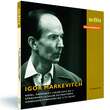






















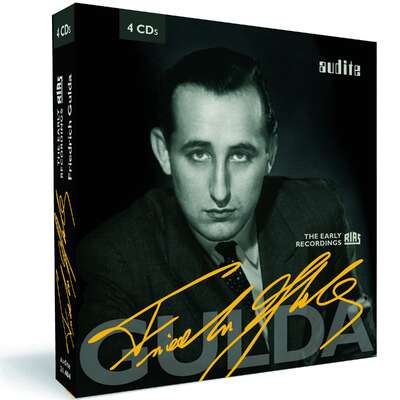
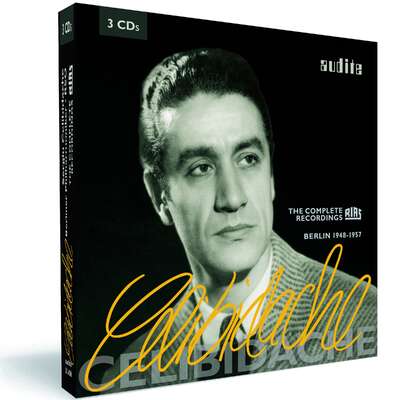

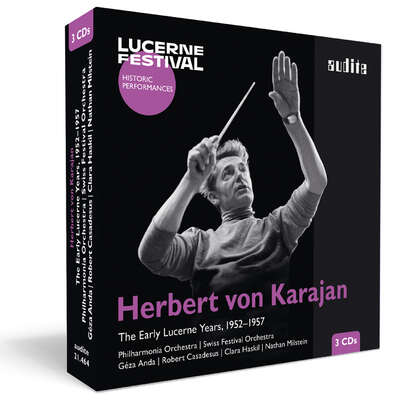
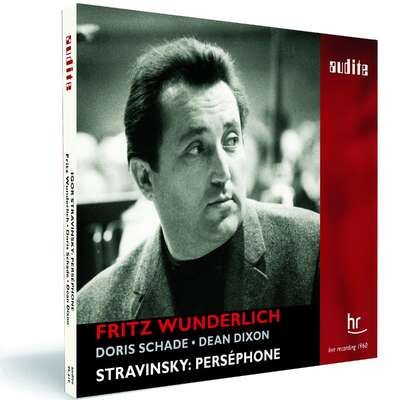
![23446 - k[NOW]n Piano](/image/product/3d/carousel/23446-known_piano.jpg)
